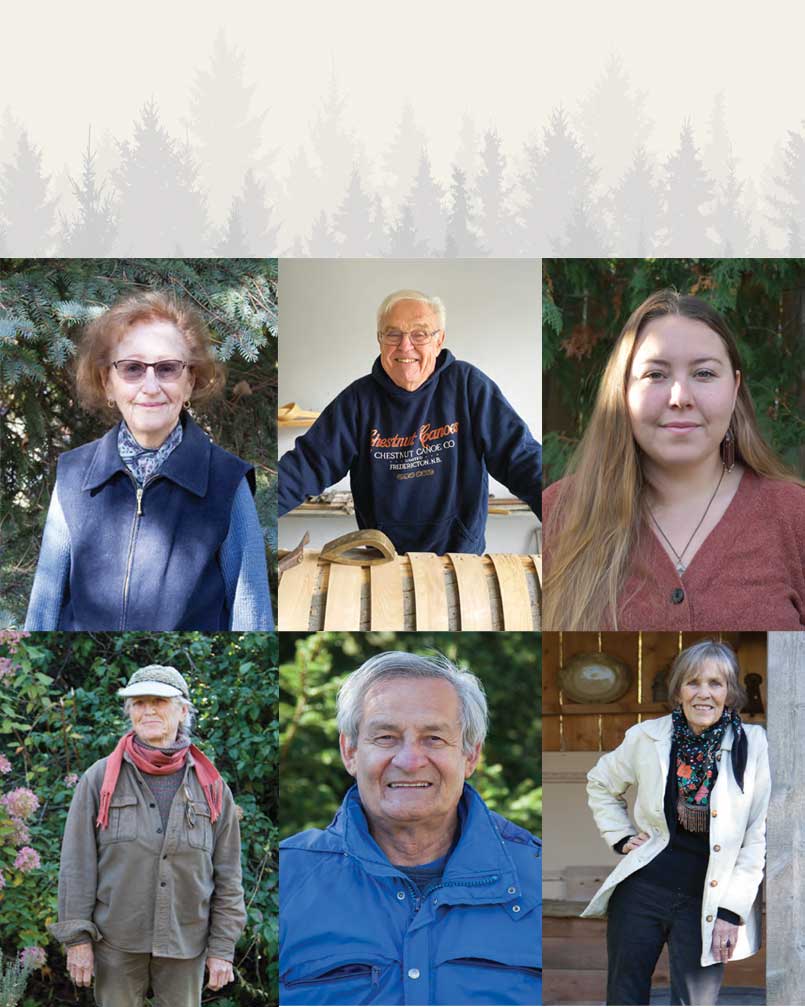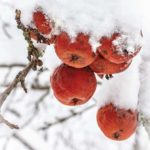
Clockwise: Norma Martin, Richard Bird, Kassie Mckeown, Amy Quinn, Rick Beaver, Kathryn McHolm
Nothing is more important than caring for our planet. Meet six local environmentalists who go above and beyond to protect and preserve our watersheds – and encourage others to do the same.
Diversity, interconnection and great people. These are the themes we heard about again and again when we set out to discuss ideas with our environmental champions.
Diversity became apparent as we uncovered the many ways these environmentalists choose to make a concern for the planet central to their lives. We found ourselves talking to artists, writers, biologists, teachers, canoe builders, landscapers and community activists, with most of them taking on at least a couple of those roles.
Interconnection revealed itself in a similar manner. One of the foundational premises of ecology is that all things on this planet are intimately connected. Our environmental champions take this theme seriously, linking the quality of their individual lives with the good of the Earth we all share.
One of the foundational premises of ecology is that all things on this planet are intimately connected. Our environmental champions take this theme seriously.
Obviously the environmentalists we spoke with are “great people,” by anyone’s definition of the term. And here we must stress that they are representative of many, many more in our community. The other part of the “great people” theme is that we heard about the value of getting involved with environmental activities and organizations, and in doing so connecting with some of the nicest, most helpful and knowledgeable folks you could hope to meet. What further motivation do you need?
RICHARD BIRD
The south shore of Prince Edward County is one of Ontario’s principal bird migration staging areas, so keeping its shorelines and wooded areas untouched is of prime importance.
Belleville resident Richard Bird is one of a corps of volunteers who have worked tirelessly over the past few decades to do just that, maintaining the County’s conservation lands through organizations such as the Hastings and Prince Edward Land Trust and the South Shore Joint Initiative.
Along with his direct involvement in local community groups, he’s helped fund their activities through another of his passions: building cedar and canvas canoes, which he donates to be raffled or sold as fundraisers. As of this fall, he was working on his 30th canoe. And nothing goes to waste. Richard turns leftover wood from canoe-building into nesting boxes for bluebirds – about 1,000 so far.
It all seems a natural outcome for a boy who grew up on the Bay of Quinte and spent his spare time on the water. “That’s how I got building canoes,” he says. A recent addition to the Hastings and Prince Edward Land Trust portfolio is the 490-acre Miller Farm near Milford, which includes approximately two kilometres of vital Lake Ontario shoreline. The land trust has also been working with the Nature Conservancy of Canada to acquire four other County properties and is negotiating with the federal government to purchase historical Lake Ontario lighthouses at Point Petre, Main Duck and Sweatman Island. “We want them preserved,” Richard says. If the track record of Richard Bird and the organizations he works with is any evidence, the odds of the lighthouses surviving seem pretty strong. In 2018, he and other County conservationists successfully fought a legal battle against the proposal to build wind turbines on the south shore. “That took up one or two canoes,” he jokes.
Another ambitious project Richard is involved with is the South Shore Joint Initiative’s appeal to the Province of Ontario to place about 4,000 acres of land in the Point Petre Provincial Wildlife Area and the Ostrander Point Crown Land block into a Conservation Reserve. This will formally protect the natural features of the two areas, which include their undeveloped shoreline.
His advice to anyone who would like to get involved is to join a local conservation or environmental organization. The Prince Edward County Field Naturalists, which Richard describes as a “really good group” and the Prince Edward Point Observatory offer great opportunities to learn about local ecology and do important work. “It’s also a chance to meet interesting people,” he says.
Explaining his own motivation, he comments, “We are trying to save a little bit before it gets gobbled up by developers. Plus, I like building canoes.”
NORMA MARTIN
Get out in nature in any way you can. That’s Norma Martin’s advice to Watershed readers who’d like to do their part to promote a healthy environment.
“Just get out and take a walk,” she says. “Because we’re all connected with nature.”
Norma Martin’s life certainly reflects the advice she provides. A spry 95-year-old, Norma met her husband, Norman, while working as a camp counsellor in Algonquin Park, where he was one of the first park naturalists. They subsequently attended the University of Illinois, where he earned a PhD in Ecology and she did work in plant pathology.
Their mutual passion for the environment came together in a 20-year study of Ontario’s forests, from Hudson’s Bay to Lake Erie, which the couple published in 2009 as The Biotic Forest Communities of Ontario. “It was wonderful,” she says of the experience of writing the book.
Norma’s background in botany and her interest in publishing served her while working with Catherine Milne and Donna S. McGillis on the history text, Gores Landing and the Rice Lake Plains, published in 1986. The Gores Landing book combines ecology with stories of early pioneers and local notables such as writer Susanna Moodie, her sister, naturalist Catharine Parr Traill, and Gores Landing canoe builder Daniel Herald, whose canoes were world famous for their quality of construction and speed.
The Martins themselves were woven into local history, as Norman Martin served in the area for 31 years as the Anglican priest for the combined Parish of Perrytown and Gores Landing.
The couple retired to Belleville in 1988 where they began their work on Biotic Forest Communities of Ontario. Norman Martin passed away in 2014, but Norma continues to write, providing regular items on nature and ecology to her condominium newsletter.
Climate change, she says, “is a big wakeup call. We all have a responsibility to nature. We are all still evolving. I think mankind is becoming more and more aware.”
AMY QUINN
Ask Amy Quinn about the best part of being an environmentalist in Watershed country and she’ll tell you it’s the quality of people you meet, whether birdwatching with the Willow Beach Field Naturalists or buying organic foods from one of the young farmers settling in the area.
“What makes me excited are the young people coming here to start small local organic farms,” she says.
Amy was born in Centreton and today lives not far from the farm where she grew up. Her working career included 30 years in the landscaping and horticulture industry. During those years she discovered the work of ecological pioneers such as Suzanne Simard – a professor at the University of British Columbia who studies how living fungi and roots interact to enable trees to communicate and exchange nutrients in the forest ecosystem.
Throughout her career Amy has incorporated native plant species in her well thought out garden designs, an approach now gaining wider momentum among horticulturists, thanks to its potential to reduce maintenance, reduce requirements for water and fertilizer, and benefit pollinators, birds and other wildlife that have co-evolved along with those native plants.
“When I started 30 years ago, not many saw the value in planting native,” Amy says. “Kathryn McHolm was about the only other person I knew who did. It has only been in the last ten years that people appreciate the value of native plants to the ecosystem.”
Most recently her work with native plants, and involvement with the Northumberland Land Trust, has led to her being designated the land steward for the Chub Point Nature Reserve, a 17-acre parcel located just south of Grafton.
She describes a recent visit to the Chub Point and surrounding areas to document its flora and woody plants, which included the pleasant surprise of finding locally uncommon species such as striped maple as well as a profusion of hophornbeam on a drumlin slope just to the northeast of the reserve, which have established themselves because the area has been relatively undisturbed by human activity.
Amy actively petitioned the Ministry of Transportation to preserve and protect the environment along the Highway 401 corridor. She’s thrilled that two wildlife corridors, one just north of the Barnum House Conservation Area and the other at Shelter Valley Road, are included in the project to widen the 401 to three lanes from east of Cobourg to Colborne.
Amy’s advice to anyone interested in making a positive contribution to the local environment is simple: join an organization in your community such as the Willow Beach Field Naturalists or the Northumberland Land Trust and enjoy the opportunity to both learn and meet some great folks. And perhaps on the way home, drop into a local organic grower.
“We need to know about these young local people. We need to keep farmers here in Northumberland and need to adjust our tax base to support smaller farms.”
RICK BEAVER
Biologist, artist and practitioner in the restoration of tallgrass prairie ecosystems, Rick Beaver expounds the Indigenous view that everything is connected to everything else, from the trees in the forest to the money in your bank account. “We need more emphasis on the economics of the environment,” he says. “Every dollar that’s ever been spent has been made from the planet.”
The theme of interconnection is central to his life’s work. A Mississauga Ojibway, he trained as a biologist and put his natural talents to work as an artist, painting and exhibiting for more than four decades. More than 20 years ago, he applied his formal training to the plants of his home community of Alderville and determined that many, including some that are unique, were in the group of species associated with tallgrass prairie, a globally rare ecosystem that now only exists in scattered patches in central North America. Factors that have reduced tallgrass prairie to a scant two or three percent of its former size include agriculture and the suppression of fire, as regular burning of vegetation helped maintain its plant systems.
Around 2000, Rick approached Alderville council with a recommendation to re-establish an area of tallgrass prairie as a cultural and heritage preserve.
Rick Beaver expounds the Indigenous view that everything is connected to everything else, from the trees in the forest to the money in your bank account.
Rick led efforts to manage and maintain the 175- acre Alderville Black Oak Savanna until 2015. His interest in the environment and ecology continues in his art, which often includes images of rare and endangered species such as orcas and monarch butterflies; he uses these to support environmental organizations such as Ontario Nature.
Rick says there are many ways in which individuals can contribute to a healthy environment. One is to start including local native plants on your home property. Another is to start making those connections between your dollars and the planet’s ecological health. “If you are a retired person, get advice on responsible investments. Check how your money is being managed with respect to the environment.”
KATHRYN MCHOLM
Kathryn McHolm describes herself as an artist, ecological gardener, naturalist and a generator of alternative ideas and sustainable ways. “Thinking about the environment and how to deal with it is innate with me,” she says. “It’s a way of life.”
Kathryn was one of the original members of the Port Hope Ecology Garden in the 1990s, where she was mentored by long-time local environmentalist Pat Lawson. Later, she came up with the idea of the Living Green Fair and a tour of alternative gardens and building types. She was also involved with the Sustainable Living Village at the Shelter Valley Folk Festival, organizing displays and workshops.
“I like to think I try to influence people to change their gardening procedures, mostly by example.” She notes that the ditch in front of her home in Welcome is filled with goldenrod and wild asters, helping to qualify her property as a Monarch Waystation and a wildlife-friendly habitat. She often shares her garden on public tours, showing how she conserves water, contends with “weeds,” and grows vegetables among the pollinating plants in her perennial borders.
Her educational activities continued at the Port Hope Fair, where Kathryn headed up the Natural Living area, demonstrating sustainable approaches to living such as cooking with a solar oven, making paper, and “upcycling” used items.
She’s also chair of The Friends of Wesleyville Village, a group that is restoring, reusing and repurposing the local buildings and creating a nature trail – projects that help promote a renewed community spirit.
Kathryn’s inspirations for her work have come from sources close to home and she attributes her lifelong interest in recycling and reusing to observing her grandmothers, who made quilts and collected stockings for hooking rugs.
“I strive for zero garbage. I like cradle-to-grave thinking when I purchase something. Where is it going to end up?” asks Kathryn. “Stores are often just organized landfill. Try to get people – without preaching – to think about that.” “Think of bees, butterflies and birds when planting a garden,” she advises. “Watch what you buy, and think about where your purchase will end up. Change your mindset. If something breaks down, perhaps it could be repurposed.”
KASSIE MCKEOWN
It was a revelation for Kassie McKeown to learn she could make a career out of protecting the environment. Now she is set on learning the technical and people skills required to serve her home community. Kassie, who describes herself as “a proud Anishinaabe-kwe from Alderville First Nation,” discovered her passion for environmental work while working as a summer student at the Alderville Black Oak Savanna. “That really put it all together for me.”
Her subsequent studies included a BA in Law and Indigenous Studies from Carleton University and a certificate in environmental planning from Fleming College’s School of Environmental and Natural Resource Sciences. She now works at Cambium Indigenous Professional Services (CIPS) in Curve Lake. The CIPS mission is to “improve the Indigenous economy through knowledge exchanges, cross cultural capacity building efforts and technical excellence.”
Working with CIPS has provided Kassie with a wide variety of unique learning opportunities. When we spoke to her in late October, she was working on soil remediation at Canadian Forces Base Petawawa. Other experiences have included working with First Nations communities to develop sustainable energy sources and creating an online land development resource toolkit that integrates Indigenous needs and priorities with land use planning. “This includes the braiding of Western science with traditional ecological knowledge and practices,” says Kassie.
Western science and traditional knowledge can flow both ways, as Kassie demonstrated while working on a federal government project to integrate traditional knowledge in the management of wildfires. The project included a round table discussion with Indigenous Fire Knowledge Keepers across Canada.
Kassie’s end goal is to take all her learning and experience back to her community. In doing this, she hopes to “facilitate the connection between people and the land.”
She acknowledges that learning about environmental issues and becoming aware of the enormity of the problems we face can lead to a sense of despair. Her recommendation is that we begin reconnecting with nature by learning about the land in whatever community we live in. Somewhat surprisingly, modern technology, such as the popular iNaturalist cell phone application, can help with that process.
Kassie also suggests becoming a volunteer. Her own experience includes volunteering with the Ontario Turtle Conservation Centre, which rehabilitates injured turtles, carries out research and education programs, and encourages private property owners to become turtle stewards by installing nest protectors – simple metal screens that keep out predators. “It makes you feel like you’re doing something,” says Kassie.
Story by:
Norm Wagenaar




